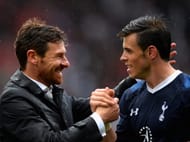He had tried to enforce a 4-3-3 at Spurs as well during the start of the season, but because they lost key transfer targets (a deal for Joao Moutinho fell through on the final day, Oscar was snapped up by Chelsea), the tactic could not be implemented properly. This forced AVB to make yet another change, signalling another step in Tottenham’s tactical evolution. He did this by moving Bale to the right wing, and shifting Gylfi Sigurdsson into Bale’s old position at left wing.
Bale used this new position to devastating effect, cutting in regularly onto his stronger foot and unleashing venomous strikes. His goals against Manchester City, Wigan and Southampton all came from the right side of the pitch, as he finished the season in this position.
Overall, AVB’s experiments with Bale and Tottenham produced mixed results. Even though Tottenham missed out on Champions League qualification, Gareth Bale ended up winning the PFA Young Player of the Year and the PFA Player of the Year awards. Although the footballing fraternity praised Gareth Bale for maturing as a world class talent, AVB’s contribution in making him brilliant lay intertwined in commendable footballing logic.
Preparing for the 4-3-3
Although Spurs finished decently enough, the fact of the matter was that CL qualification had eluded them for the second year running. In the close season though, AVB has been hard at work to correct his mistakes from last season, starting from getting his preferred formation, the 4-3-3, up and running.
After seeing that Bale had fit excellently into his role on the right wing (alarmingly similar to the role the left footed Hulk played in his Porto side), he worked on getting the other aspects right. After losing out on a world class midfielder to play in the centre of his 4-3-3, he splashed the cash on one of the most exciting talents in the Brasilerao, as Paulinho arrived at White Hart Lane for 17 million GBP.
Paulinho, a box to box midfielder, offered an excellent all-round option in the formation, and on paper looks like an intelligent buy. Paulinho’s devastating aerial prowess aside, he offers a powerful presence in midfield, combining a resolute defensive presence with lung-bursting runs into the box. What Paulinho’s signing also does is that it allows Dembele to move into his preferred attacking midfield position more often, as the defensive work is now taken care of by Paulinho himself and the other midfielder, who could be either Sandro or Scott Parker.
The other flaw AVB recognised was that Gylfi Sigurdsson on the left wing wasn’t really an enticing prospect. In a system which relied on counter-attacks being initiated from the wings, Sigurdsson was found wanting on several occasions. Hence, to compensate for the lack of pace on the wing, Tottenham agreed to sign Nacer Chadli, a pacy winger who will fill in some of the gap left by Bale’s destructive wing play.
Considering that Tottenham’s forwards were not too impressive last term, AVB has been quick to delve into the transfer market for good options. Christian Benteke might have slipped out of their hands, but their long standing interest in Internacional forward Leandro Damiao and the recent talks with Valencia striker Roberto Soldado are massive statements of intent from the Tottenham manager.
Everything being said, Tottenham look well and truly on their way to making a strong team for the upcoming campaign. Whether Tottenham adapt well to the 4-3-3, or if Bale’s run of form continues, are questions which will make Tottenham an intriguing watch come August.

